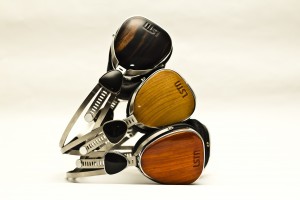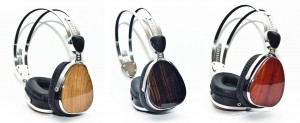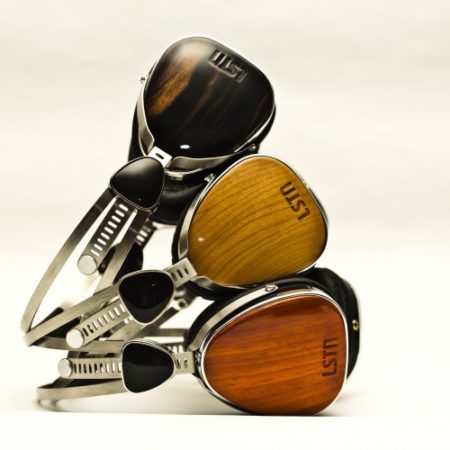
LSTN is a relative newcomer to the world of personal audio, but it has been making big splashes recently with their dedication to a mix of social entrepreneurship, philanthropy, and conservation measures. Rarely do you see a company, especially a new one, take a head dive into a cause that they believe in and build a product around it. LSTN is defined by their actions, which may at times seem louder than words. However, with the introduction of the Troubadour on-ear headphone, we can finally put some sound to their company philosophy.
The company boasts a plethora of conservation measures that will amaze anyone that sees them. From the very moment you lay eyes on the Troubadour’s retail box, you’ll notice that centered right in the front, we get a message. This time however, it isn’t about the product, but rather about how with every pair of cans purchased, LSTN will restore hearing to a person through the Starkey Hearing Foundation; there are videos on their website that shows their efforts and statistics. Since then, LSTN boasts that they have personally given over 15,000 people the ability to hear again. Their inspirational videos and background information on the website left me speechless afterwards.
While the company is certainly impressive in ‘giving back’, their Troubadour headphone is equally as monumental to their cause. On the back of the box we are met with some bolded details of the headphone. The biggest item of notice being that their headphones are made of real wood. However, it’s not just any wood, it’s made of reclaimed exotic wood such as the likes of Zebra, Ebony, Cherry, and Beech Wood. They claim that they source them from furniture and flooring manufactures and ‘reclaim’ them so they can be re-used again. These exotic woods took many years to get to this point, it would be a waste to just dispose of them when they are still ‘useful’. LSTN bridges a social cause and sustainable measures with a product of theirs. Their line of headphones are the results of their company philosophy that “good business should be good for the world”.

Upon seeing the headphone, I thought to myself if this could be ‘my moment’. See, I was born in the 90s and thus was never able to really experience any of that retro-nostalgia that I’ve heard so much about. The Troubadours sport a metal headband, plastic driver housing, and wooden cups. And despite how it may look at first, on closer inspection, the headphones are actually more post-modern in style than retro due to the juxtaposition of both old and new together. It features the sleek lines and sharp metal construction of the ‘new’, while its wood and general structure keep it grounded in the ‘old’. I find that the Troubadours sport a look that is not offensive and works well for most people that are seeking to purchase it. There are indeed some out there that do not wish for a headphone that was inspired from such an era, but, overall, I feel like there are more out there that would than wouldn’t.
The comfort of the Troubadour is largely dependent on its swivel mechanism, and pads. The headphone uses a rudimentary (but fitting) system of arms and attachments to create the movement in the headband and driver housing. This is needed to ‘mold’ the headphone to your head to get optimal sound. Whereas most headphones have a large degree of freedom (much more so than humanly needed or possible usually), the Troubadours is quite constricting. The moment you get them you’ll notice that the driver housing only turns slightly and that the up/down swivel is also confined. This is a limiting factor of the headphone that it actually uses as strengths. Each driver is independently connected on the bottom meaning there is no wire that goes through the headband. Without restriction on these drivers, they will flip and turn every other way due to this freedom. I’ve personally not yet met a problem where the restrictions have affected my usage of them. Yeah, you can’t turn the pads outwards when the unit is one your neck as a way to project sound like a speaker, but you shouldn’t be doing that anyway. Past that, the pads are, of course, the largest contributor of personal comfort. The pads are plush and soft while still offering enough back force so that it doesn’t completely deflate on you. Pretty standard stuff for the most part except that there is a tension force of sorts in the headband. This snaps the unit into the U shape that it is in and puts some added pressure on the head (a standard of on-ear headphones) which does make it a bit annoying for the first few hours you have with the unit. But once you’ve gotten more used to them and have broken them in like you should every unit, they rarely pose an issue.
From a utility sense the Troubadours are seeking to cover more advanced bases than standard,but are also losing some. The headphone has 2.5mm singled channel plugs on the bottom of each driver so that the detachable cable can connect to it. This is a bit more advanced that what most units utilize and its ‘fanciness’ does benefit it when you are looking for more customization and future durability. The issue then is that it is cheaper to replace a headphone cable that is a 3.5mm stereo detachable than it is for the one on the Troubadour. The standard here just isn’t that popular or used often making it slightly more difficulty to find third-party solutions. The next order of business is that there is an additional microphone/button on the Troubadour and its detachable cable. For one reason or another, I’ve faced some difficulties with the Troubadour and this feature. On DAPs or computers that accept the ‘three pronged’ 3.5mm TRRS input, I’ve gotten interference, with the sound where artifacts, or electrical pops may happen. I believe the ‘button’ on the unit is affecting the devices somehow through a false signal of sorts. It doesn’t happen often, but when it does, it can be a bit annoying. Another unforeseen issue is that the microphone is at such a height that it becomes a bother to people that wear pollos or jackets with clingy surfaces. More than once, I’ve had to free the block microphone structure from my clothing. It’s rather annoying to be honest. In the end, while I admire LSTN for incorporating these slightly more advanced features into the headphone, they do give away some of the utility of the unit and make some things harder to use at times.
The Troubadours are minimal in their representation, a bit woefully so at times. The headband at the very top is made of a piece of metal that looks like it was just cut from the press. It has a slightly sharp feel to it due to this. To people that like industrial products, they may prefer this, but I found it a bit too ‘raw’ and underdeveloped for my liking. The headband is essentially a few thinly cut pieces of metal with an adhesive pad on the bottom of the bars to provide comfort. It works fairly well, but it looks more like something that would be considered temporary than not. Not saying that they need to over-engineer it by any means; this is their style of course. But that I would like to see a bit more ‘engineering’ in the product.
In the end, I am quite amicable with the design and feature set of the Troubadours. I find them to be just about right for the job doing what needs to be done without the need for excess. I would like to see a bit more development of the frame in the future however.
The question that always comes up with portable units is on how well it is driven or if you need additional amplifiers or DACs for it. The answer for the Troubadour is that it doesn’t really need any. It is fairly efficient with power and has a laid back signature. One would generally put expensive amps and DACs on active headphones that really let the detail changes shine through. The headphones do not get as loud as other portables do in a dB sense, but I think this is intentional. Part of LSTNs purpose is to not kill your hearing. It gets just loud enough to be very satisfying but not past levels that are actually ‘rock-on’ loud. Quality over sonic quantity my friends, you could amp this yes, but you are better getting another can with a different company philosophy if you were the kind to want to rock.
General sound signatures of headphones are an important facet of what defines them in relation to other cans in the ‘ecosystem’. The Troubadours are laid back, dark, and decently bassy with a warm treble. It has a deep sound to it where it is fairly in the ‘background’ rather than in your face. I found it to be quite pleasant to listen to when you are doing erroneous tasks or web surfing; these don’t fit the critical listening roles.
The tonally warm Troubadour’s are quite welcoming thanks to their natural and spacious vocals. Listening to “Lune(Gringoire)” of the album Notre Dame de Paris was quite dramatic on the headphone. I use this live album to be a pass mark test for both active and passive listening situations. The Troubadour’s struck a good balance of being in the ‘background’ while also delivering enough of the juicy vocals to keep me interested. The song “Lune” is a delicate piece that requires careful precision in the voclular section of a headphone. What stood out was that the singer had quite a natural sensation to his tone. It had a humane undertone to it thanks to the dark background and ‘lower mid’ focus of the headphone. It is without its problems though. The vocals are unable to hit higher sections without straining and lack elements of macro and micro detail. For a portable headphone in this price range, it is to be expected however.
The spatial background of the Troubadour give it some tricks. I never expected the unit to have the slight spatial background it does. I was anticipating a very ‘closed’ and narrow soundstage and spatial presentation. Instead, we are given a dimensional feel to the unit that is just enough for it to be noticeable and pleasant for most genres. It doesn’t go into full-open headphones territory or those of closed headphones that ooze imaging abilities but it handles itself well for what it is. It worked quite well on the AudioSTAX and Ultrasone 3D test tracks I threw it on. I wasn’t expecting anything mind boggling (and it wasn’t), but it is always nice to have especially in the quantities of the Troubadours where it doesn’t take away from the original material.
Gaming was quite pleasant with the headphone thanks to the compact unit and soundstage. I would never outright recommend these as gaming cans. They aren’t, not by a long run. However for those that would like to know how these fare, I would just like to say that it worked quite well for me. I used these on Alien Isolation (horror, exploration, strategy) and World of Tanks (action, MMO, open map). They performed amicably by giving me a more laid back presentation of the game while still allowing me to ‘hear’ the map in its surrounding glory. Whereas some would recommend active and fully open cans for games, I believe that a laid back presentation works for just that, a laid back gamer that needs a mellower feel of the game. These cans deliver on everything and also include a microphone for laptops (and special desktops) that include a single 3.5mm jack for volume and microphone. The problems I encountered in using them for gaming was mainly that they would get hot after a few hours of usage. Overall, I would recommend these cans for the casual listener that also likes to play a game here and there.
Bass is one of the headphones better tricks, its poignant without over muddying itself. One of the first tracks I put on the Troubadour was “King Kunta” by Kendrick Lamar’s new album To Pimp a Butterfly. The Troubadour produced this deep and low rumble to accompany the track with every beat. It operates almost like a separate sub than a combined single driver unit is what it sounds like. Where the bass almost ‘accompanies’ it rather than becomes a part of the song. It operates best with lows in the sub-bass followed by a decent mid-bass bump. They deliver a satisfying kick to most music I have listened to. The problem however is that you can’t overdo it with the volume, else the faults in the bass start to show. Turning up the volume will start distorting the bass on the Troubadour to where it starts to unproportionately deliver too much thump or a sub distortion. Yes, this does happen with headphones, but the Troubadours are more susceptible to it from my usage.

Overall for the $149.99 retail price I find the Troubadour to be a nice product. It doesn’t reinvent the wheel, but you are getting a well-built one. It is better than the baseline product of this range in sonic reproduction and also has roots in conservation which is what makes it stand out. The company dream and direction they are pivoting towards is something that I personally and many out there believe in. It’s an interesting take on mixing business with Samaritan morals. It’s companies like LSTN that will be a part of the more sustainable future and I’m sure glad they are making headphones. They are almost there in making a truly breakthrough product and I think that if they push on they will reach it in the next few years. The Troubadours hold their own place in time quite admirably, but I can see so much more in the future.















Want to join discussion?
Feel free to contribute!